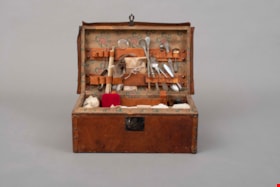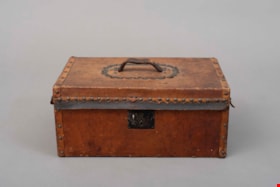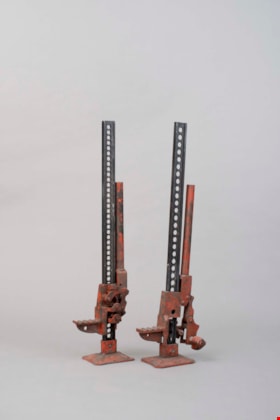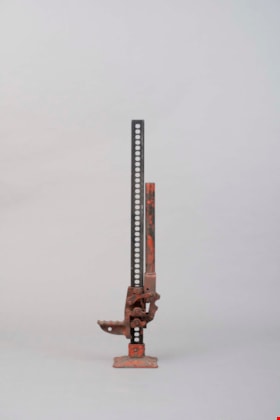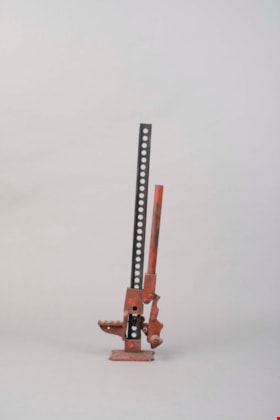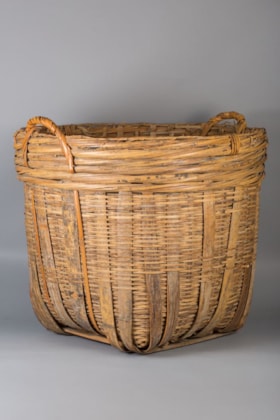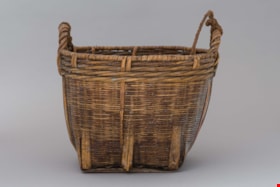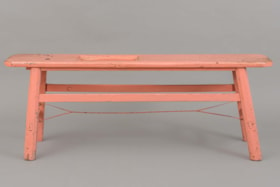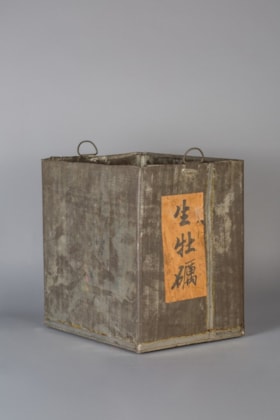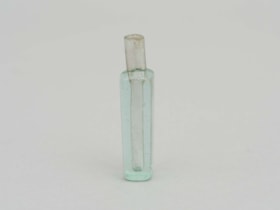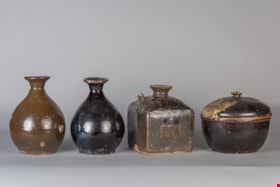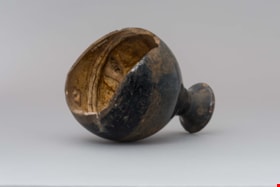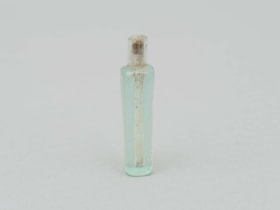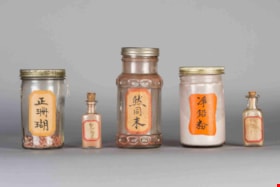More like 'Group of young men'
Narrow Results By
Decade
- 2020s 36
- 2010s 45
- 2000s 60
- 1990s 91
- 1980s 85
- 1970s 78
- 1960s 69
- 1950s 61
- 1940s 46
- 1930s 66
- 1920s 26
- 1910s 13
- 1900s 8
- 1890s 3
- 1880s 1
- 1870s 1
- 1860s 1
- 1850s 1
- 1840s 1
- 1830s 1
- 1820s 1
- 1810s 1
- 1800s 1
- 1790s 1
- 1780s 1
- 1770s 1
- 1760s 1
- 1750s 1
- 1740s 1
- 1730s 1
- 1720s 1
- 1710s 1
- 1700s 1
- 1690s 1
- 1680s 1
- 1670s 1
- 1660s 1
- 1650s 1
- 1640s 1
- 1630s 1
- 1620s 1
- 1610s 1
- 1600s 1
Subject
- Adornment 29
- Adornment - Jewelry 1
- Adornment - Lapel Pins 27
- Advertising Medium 9
- Advertising Medium - Signs and Signboards 5
- Agricultural Tools and Equipment 3
- Agricultural Tools and Equipment - Gardening Equipment 1
- Agriculture 7
- Agriculture - Crops 1
- Agriculture - Farms 9
- Animals - Deer 1
- Archeological Specimen 33
Interview with Harry Toy, Beverley Babey and Christina Toy
https://search.heritageburnaby.ca/link/museumdescription20285
- Repository
- Burnaby Village Museum
- Date
- [1905-2023] (interview content), interviewed 25 Sep. 2023
- Collection/Fonds
- Burnaby Village Museum fonds
- Description Level
- Item
- Physical Description
- 1 sound recordings (wav) (121min., 14 sec.) + 1 sound recording (mp3) (121 min., 13 sec.)
- Scope and Content
- Item consists of a recording of an oral history interview with Harry Toy, Beverley Babey and Christina Toy conducted by Burnaby Village Museum researcher Denise Fong on September 25, 2023. The interview is divided into four sections: early life of Harry Toy, the Canada Way Food Market, the Fraser M…
- Repository
- Burnaby Village Museum
- Collection/Fonds
- Burnaby Village Museum fonds
- Series
- Museum Oral Histories series
- Subseries
- Many Voices Project Interviews subseries
- Description Level
- Item
- Physical Description
- 1 sound recordings (wav) (121min., 14 sec.) + 1 sound recording (mp3) (121 min., 13 sec.)
- Material Details
- Interviewer: Denise Fong Interviewees: Harry Toy, Beverley Babey and Christina Toy Location of Interview: Residence of Harry Toy Interview Date: September 25, 2023 Total Number of tracks: 1 Total Length of all Tracks: 02:01:13 Digital master recording (wav) was converted to mp3 for access on Heritage Burnaby
- Scope and Content
- Item consists of a recording of an oral history interview with Harry Toy, Beverley Babey and Christina Toy conducted by Burnaby Village Museum researcher Denise Fong on September 25, 2023. The interview is divided into four sections: early life of Harry Toy, the Canada Way Food Market, the Fraser Merchants’ Association and Harry's daughters, Beverley Babey and Christina Toy's memories of growing up in Burnaby. 00:00:00 – 00:23:53 Harry Toy shares biographical information about himself and his ancestors. Harry provides information about his migration to Canada and his life in Manitoba, attending school, working at the family restaurant and teaching high school. 00:23:53 – 00:41:16 Harry talks about moving his family to Burnaby and his experiences owning and operating the Canada Way Food Market. 00:41:17 – 00:54:19 Harry talks about his involvement with the Fraser Merchants Association (FMA) and provides some history about the organization. 00:54:20 – 1:22:44 Harry talks about running the Canada Way Food Market and the alterations that he made to the store over the years. Harry and his daughters comment as they look through photographs of Harry and his store and the Fraser Merchants Association. 1:22:45 – 2:01:14 Beverley and Christina talk about their early childhood in Manitoba and growing up in Burnaby. They recall what it was like growing up and working in the family owned store.
- History
- Interviewee biography: Harry Wee Koon Toy was born in February 9, 1936 in Taikong, Toisan county, Guangdong, China. Harry's father William Toy came to Canada in the early 1920s when he was ten years old. Harry arrived in Vancouver, Canada on September 9, 1950. After staying in Vancouver for one night, he joined his father in Neepawa, Manitoba where the family operated a cafe business (Royal Cafe). Harry grew up in Neepawa and graduated from the University of Manitoba and teacher's college. He became a high school teacher and worked at schools in Minnedosa and Gladstone, Manitoba teaching various subjects including, science, business, geography, history and physical education. Harry and his wife, had three daughters, Melinda, Beverley and Christina who were all born in Neepawa. When the family decided to move to the west coast, Harry was introduced to the grocery store business through an uncle who was a store operator. Around 1970, Harry purchased a grocery store at 4694 Canada Way in Burnaby which he named "Canada Way Food Market" and Harry and his daughters made their home at the back of the store. Harry owned and operated the store for approximately 40 years between 1970 and 2010. Around 1986, Harry purchased the butcher shop next door (4692 Canada Way) which was no longer in operation, expanding his store and adding a second storey to use a residence. Harry's children helped him operate the store throughout their childhood. In the early 1970s, corner stores were threatened by the spread of small chain-operated convenience stories from Eastern Canada to Vancouver. Formed in April 1972, the Fraser Merchants’ Association was established to protect the rights of corner store operators. With no paid legal help, the association was incorporated in Victoria, BC for the cost of 56 cents. The benefits of being a member of the association included warehouse and group purchasing, common advertising and other advantages of being part of an association. Founded by Gary Lee Ling and five others, Fraser Merchants’ Association’s first member was Graham Grocery. By 1978, the association represented over 200 corner stores in the Lower Mainland (Delta, Surrey, White Rock, Langley, Coquitlam, and New Westminster) and Fraser Valley. The association remained active into the 1980s and 1990s. Harry has served as President of the Fraser Merchants' Association from 1992 to present. Interviewer biography: Denise Fong is a historical researcher at Burnaby Village Museum. She has degrees in Anthropology (BA) and Archaeology (MA), and is completing her doctoral degree at UBC in Interdisciplinary Studies. Her primary research interests are in Chinese Canadian history and critical heritage studies. She is the co-curator of BVM’s “Across the Pacific” exhibition, and the Museum of Vancouver’s “A Seat at the Table – Chinese Immigration and British Columbia”.
- Creator
- Burnaby Village Museum
- Subjects
- Education
- Migration
- Occupations - Teachers
- Occupations - Grocers
- Organizations
- Organizations - Business Associations
- Persons - Chinese Canadians
- Social Issues
- Social Issues - Racism
- Buildings - Commercial - Grocery Stores
- Names
- Toy, Christina
- Toy, Harry Wee Koon "Harry"
- Babey, Beverley
- Canada Way Food Market
- Fraser Merchants' Association
- Responsibility
- Fong, Denise
- Geographic Access
- Canada Way
- Street Address
- 4694 Canada Way
- Accession Code
- BV023.16.19
- Access Restriction
- No restrictions
- Reproduction Restriction
- No known restrictions
- Date
- [1905-2023] (interview content), interviewed 25 Sep. 2023
- Media Type
- Sound Recording
- Related Material
- See also: BV023.25 - Harry Toy fonds
- Notes
- Title based on contents of item
- Transcription available
Documents
Audio Tracks
Interview with Harry Toy, Beverley Babey and Christina Toy, [1905-2023] (interview content), interviewed 25 Sep. 2023
Interview with Harry Toy, Beverley Babey and Christina Toy, [1905-2023] (interview content), interviewed 25 Sep. 2023
https://search.heritageburnaby.ca/media/hpo/_Data/_BVM_Sound_Recordings/Oral_Histories/2023_0016_0019_002.mp3Interview with Ken Yip May 9, 2005 - Track 3
https://search.heritageburnaby.ca/link/museumdescription4533
- Repository
- Burnaby Village Museum
- Date
- 1950s & 1960s (interview content), interviewed May 9, 2005
- Collection/Fonds
- Burnaby Village Museum fonds
- Description Level
- Item
- Physical Description
- 1 sound recording (mp3) (0:06:07 min)
- Scope and Content
- Track 3: This portion of the recording continues with Ken’s band activities, and then pertains to the games Ken played with his brother and friends. Ken discusses how the school band’s repertoire and performances were designed to complement the school’s events throughout the year. He describes the …
- Repository
- Burnaby Village Museum
- Collection/Fonds
- Burnaby Village Museum fonds
- Series
- Museum Oral Histories series
- Subseries
- Growing Up in Burnaby subseries
- Description Level
- Item
- Physical Description
- 1 sound recording (mp3) (0:06:07 min)
- Material Details
- Interviewer: Tom Gooden Interviewee: Ken Yip Date of interview: May 9, 2005 Total Number of Tracks: 5 Total length of all Tracks: 0:62:00
- Scope and Content
- Track 3: This portion of the recording continues with Ken’s band activities, and then pertains to the games Ken played with his brother and friends. Ken discusses how the school band’s repertoire and performances were designed to complement the school’s events throughout the year. He describes the concert the band was invited to play on the lawn of Ceperley House on their return from Expo 67. Ken recalls the games he and his brother played, and the two neighbor boys they played with. He describes playing on the North American Peat property adjacent to theirs, in the peat trenches and in the bush. He talks of roaming as far as New Westminster and the Fraser River.
- History
- Recording of an interview with Ken Yip recording by Tom Gooden on May 9, 2005. This recording was completed for an exhibit, Growing Up in Burnaby, for the Burnaby Village Museum. Major themes discussed are growing up in Burnaby in the 1950s and 60s.
- Creator
- Burnaby Village Museum
- Names
- Yip, Ken
- Accession Code
- BV017.45.5
- Access Restriction
- No restrictions
- Reproduction Restriction
- May be restricted by third party rights
- Date
- 1950s & 1960s (interview content), interviewed May 9, 2005
- Media Type
- Sound Recording
Audio Tracks
Interview with Ken Yip May 9, 2005 - Track 3, 1950s & 1960s (interview content), interviewed May 9, 2005
Interview with Ken Yip May 9, 2005 - Track 3, 1950s & 1960s (interview content), interviewed May 9, 2005
https://search.heritageburnaby.ca/media/hpo/_Data/_BVM_Sound_Recordings/Oral_Histories/2017_0045_0005_003.mp3Interview with Rajinder and Raj Pandher
https://search.heritageburnaby.ca/link/museumdescription19610
- Repository
- Burnaby Village Museum
- Date
- [1942- 2023] (interview content), interviewed Jan. 2023
- Collection/Fonds
- Burnaby Village Museum fonds
- Description Level
- Item
- Physical Description
- 4 sound recordings (wav) (186 min., 1 sec.) + 1 sound recording (mp3) (186 min., 2 sec.)
- Scope and Content
- Item consists of a recording of an oral history interview with Rajinder and Raj Pandher conducted by Burnaby Village Museum Assistant Curator, Kate Petrusa and Museum Registrar, James Binks. The interview was conducted on January 10, 2023 and January 24, 2023. 00:00 – 08:52 First part of interview…
- Repository
- Burnaby Village Museum
- Collection/Fonds
- Burnaby Village Museum fonds
- Series
- Museum Oral Histories series
- Description Level
- Item
- Physical Description
- 4 sound recordings (wav) (186 min., 1 sec.) + 1 sound recording (mp3) (186 min., 2 sec.)
- Material Details
- Interviewers: Kate Petrusa and James Binks Interviewees: Rajinder and Raj Pandher Location of Interview: Love farmhouse, Burnaby Village Museum Interview Date: January 10, 2023 and January 24, 2023 Total Number of tracks: 4 Total Length of all Tracks: (3:06:01 min) Digital master recordings (wav) were recorded onto four separate audio tracks, edited and merged together and converted to mp3 for access on Heritage Burnaby
- Scope and Content
- Item consists of a recording of an oral history interview with Rajinder and Raj Pandher conducted by Burnaby Village Museum Assistant Curator, Kate Petrusa and Museum Registrar, James Binks. The interview was conducted on January 10, 2023 and January 24, 2023. 00:00 – 08:52 First part of interview begins on January 10. Rajinder Pander provides information on where he was born and where he grew up and shares details regarding his family and his childhood including; his elementary and high school education and experiences and his involvement and interest in the sport of field hockey. 08:53 – 23:24 Raj Pander provides information on where she was born and shares details regarding her family and education. Raj recalls details of her family life in India including her family farm, her father’s service in the Indian National Army and other ancestor’s involvement in the military. Rajinder assists with the details regarding Raj’s father’s military service and explains how he was highly decelerated for his heroic actions. Rajinder conveys further information in reference to the Sikh Empire. 23:25 – 35:53 Rajinder and Raj share information on their formal education. Raj explains how she learned English and talks about the other spoken languages that her family used while she was growing up. Rajinder and Raj recall how they first met which lead them to marry in 1971. Rajinder provides information about his older brothers who left India before him. He explains how his elder brother, Kirpal Singh Pandher immigrated to Canada in 1970 and provides details on his other brother who lived in Malaysia and England before coming to Canada in 1975. Rajinder conveys how after his brother, Kirpal Singh Pandher arrived in Canada, he lived in Campbell River and worked at the saw mill there. 35:54 – 1:01:38 Rajinder and Raj share their immigration stories including details of; what lead them to immigrate, their immigration route, what they brought with them and where they lived and worked. Rajinder and Raj tell of how they both faced discrimination in finding work that they were qualified for and describe some of the jobs that they worked at before obtaining their Real Estate licences. 1:01:39 – 1:13:09 Rajinder and Raj share information on where they’ve purchase traditional food supplies in Burnaby and Rajinder provides further details on his employment and recalls how they were able to purchase their first home in Burnaby. 1:13:10 - 1:19:33 Rajinder describes how he began writing for the Sikh newsletter “The Western Sikh Samachar”. Rajinder shares how he first started printing small pamphlets of Sikh Cultural history in 1975 and how he’s been volunteering with the National Democratic Party (NDP) since 1973. 1:19:34 - 1:38:24 Second part of interview continues on January 24, 2023. Rajinder provides further information about the Sikh newsletter “The Western Sikh Samachar”, provides an historical summary of the Sikh Empire and the Sikh religion and describes a book that’s he’s written about his culture and the village he lived in India. 1:38:25 - 1:52:24 Raj describes some of the traditional textiles that she’s created including a dury, embroidered cloth (pakha and pakhi) and clothing. Raj shares a story of a train derailment in India in which her father survived. 1:52:25 - 2:14:53 Raj Pandher talks about her father’s letters and diaries, Rajinder talks about receiving a Diamond Jubilee Medal for his community service and they both talk about their daughter Amanjit’s education and career accomplishments. Raj describes her involvement in the community council of her children’s school and both Raj and Rajinder describe their involvement in multicultural education and events that they were involved with in Burnaby and New Westminster. Interviewer lists Rajinder Pandher’s many volunteer awards and accomplishments. 2:14:54 - 2:39:53 Raj and Rajinder describe some of their family photographs as well as personal items from India including decorative arts and textiles. They talk about celebrating their 30 year wedding anniversary and the origin of their Sikh names. Rajinder describes a visit to Paldi in 1977 when the whole family was baptized at the Sikh temple and provides informaton about Hardial Singh Atwal, the first Sikh child born in Canada. Rajinder discusses what he thinks a cookhouse looked like, his friendship with former Mayor William J. Copeland and wages of South Asians working in sawmills. 2:39:54 - 3:06:01 Raj and Rajinder talk about food including where they’ve purchased traditional South Asian foods and what they grow in their home garden. Rajinder provides details about the Burnaby Multicultural Society, talks about South Asian work ethics and housing and shares some of the cultural and religious traditions of Sikhs and celebrations that take place in Vancouver and Burnaby.
- History
- Interviewees biographies: Rajinder Pandher was born five years prior to the Partition of India in the Village of Jhamat, Ludhiana District, Punjab. Raj Pandher was born in 1948 in the Village of Chapar, Ludhiana District, Punjab. Rajinder played field hockey while living in India and is passionate about the sport. Both Rajinder and Raj Pahndher attended college in India and were married in India in 1971. Rajinder Pandher immigrated to Canada in 1972 and his wife, Raj Pandher joined him in 1973. After arriving in Canada, Rajinder Pandher started working at a sawmill in Campbell River but didn't like the work and moved to Vancouver to find better employment opportunties. In 1976, the couple moved to Burnaby and rented until they could buy a home a year later. They raised two children who attended Second Street Elementary School and Cariboo Hill Secondary School in Burnaby. Rajinder and Raj Pandher were both very involved with multicultural efforts at their childlren's schools including turban tying and sari demonstrations and Rajinder was a founding member of the Burnaby Multicultural Society. Interviewers biographies: Kate Petrusa is the Assistant Curator at the Burnaby Village Museum. In her role, she manages all aspects of the collection – including caring for physical artifacts and making their digital counterpart accessible. Before coming to Burnaby Village Museum in 2019, Kate has worked at several Museums around the Lower Mainland as a Curator and contractor since 2013. James Binks has lived in the Lower Mainland since 2009 after relocating from Ontario. James holds a Bachelor of Arts in Anthropology from the University of British Columbia, where he conducted researched on heritage, environment, and globalization in India, Nepal, and Italy. At Burnaby Village Museum, James contributed to the exhibit “Truths Not Often Told: Being South Asian in Burnaby”.
- Creator
- Burnaby Village Museum
- Subjects
- Education
- Housing
- Employment
- Persons - South Asian Canadians
- Persons - Volunteers
- Religions - Sikhism
- Migration
- Organizations
- Organizations - Societies and Clubs
- Social Issues - Racism
- Social Issues
- Celebrations
- Sports - Field Hockey
- Names
- Pandher, Raj
- Pandher, Rajinder
- Copeland, William J.
- Pandher, Harman
- Pandher, Amanjit
- Burnaby Multicultural Society
- The Western Sikh Samachar
- Responsibility
- Petrusa, Kate
- Binks, James
- Accession Code
- BV023.1.2
- Access Restriction
- No restrictions
- Reproduction Restriction
- No known restrictions
- Date
- [1942- 2023] (interview content), interviewed Jan. 2023
- Media Type
- Sound Recording
- Notes
- Title based on contents of item
- Transcripts available upon request
Audio Tracks
Interview with Rajinder and Raj Pandher, [1942- 2023] (interview content), interviewed Jan. 2023
Interview with Rajinder and Raj Pandher, [1942- 2023] (interview content), interviewed Jan. 2023
https://search.heritageburnaby.ca/media/hpo/_Data/_BVM_Sound_Recordings/Oral_Histories/2023_0001_0002_003.mp3Interview with Howe Lee, 2019
https://search.heritageburnaby.ca/link/museumdescription10266
- Repository
- Burnaby Village Museum
- Date
- February 20, 2019
- Collection/Fonds
- Burnaby Village Museum fonds
- Description Level
- Item
- Physical Description
- 1 sound recording (mp3) (01:18:41 min)
- Scope and Content
- Recording is an interview with Howe Lee conducted by BVM researcher Denise Fong. Mr. Lee describes growing up in Armstrong in the 1930s and 1940s, leaving to attend university, and becoming a teacher in Burnaby. He discusses his community involvement and the creation of the Chinese Canadian Militar…
- Repository
- Burnaby Village Museum
- Collection/Fonds
- Burnaby Village Museum fonds
- Series
- Museum Oral Histories series
- Subseries
- Chinese Canadians in Burnaby subseries
- Description Level
- Item
- Physical Description
- 1 sound recording (mp3) (01:18:41 min)
- Material Details
- Interviewer: Denise Fong Interviewee: Howe Lee Location of Interview: Burnaby Village Museum Interview Date: February 20, 2019 Total Number of tracks: 1 Total Length of all Tracks: 1:18:41
- Scope and Content
- Recording is an interview with Howe Lee conducted by BVM researcher Denise Fong. Mr. Lee describes growing up in Armstrong in the 1930s and 1940s, leaving to attend university, and becoming a teacher in Burnaby. He discusses his community involvement and the creation of the Chinese Canadian Military Museum Society. 00:00 – 20:39: Mr. Lee describes his family’s origins in China. Denise shows him a photograph of Armstrong and he uses it to show the location of his family’s property and other landmarks. He talks about his family’s life in Armstrong, their farm’s place in the Chinese produce supply system of the time, and the presence and life of Chinese people in British Columbia generally. Mr. Lee also relates how the Interior Vegetable Marketing Board’s policies affected the farm and his future prospects. 20:39 – 32:40: This portion of the recording pertains to Mr. Lee’s involvement with the Chinese Cultural Centre and how he developed an interest in commemorating and honouring Chinese pioneers and military veterans. He recalls his education in Armstrong and at U.B.C. and the community of Chinese students which first drew him to Vancouver’s Chinatown. 32:40 – 51:24: Mr. Lee describes his family and the Chinese community in Armstrong, using the photo to show the locations of the businesses. He recalls his involvement with youth groups, particularly the Cadets, and with local sports, noting that he faced very little discrimination there. Denise asks about the family’s farm and Mr. Lee identifies the family’s house in a drawing. 51:24 – 1:02:18: This portion of the recording pertains to Mr. Lee’s education and career. He describes his enjoyment of being a leader in various groups and activities, and his interest in the local Chinese community. He explains the structure and operation of the cadets and shares his perspective of its value in leadership training. 1:02:18 – 1:18:46: Mr. Lee recalls how he became involved with veterans and with the Chinese Cultural Centre in Vancouver. He talks about bringing his parents to Burnaby to live. Mr. Lee describes how he persuaded some veterans to reorganize their group under the Army, Navy & Air Force Veterans in Canada. He discusses the importance of documenting and passing on the legacy of the Chinese veterans’ contribution and tells how he convinced some of them to create The Chinese Canadian Military Museum Society. Mr. Lee relates how his involvement with the local society led to involvement with a national group.
- History
- Howe Lee has worked in education, business, military and within the community. He has taught Science and Mathematics in several Burnaby Secondary Schools and was head of the Science Department and Edmonds Secondary School. Lee was appointed Honorary Colonel in 2012. He has been active within the Chinese-Canadian community including working with the Chinese Canadian Military Museum, Vancouver Chinatown Memorial Square, Asian Heriage Month Society and the Chinatown Revitalization. Interviewer biography: Denise Fong is a historical researcher at Burnaby Village Museum. She has degrees in Anthropology (BA) and Archaeology (MA), and is completing her doctoral degree at UBC in Interdisciplinary Studies. Her primary research interests are in Chinese Canadian history and critical heritage studies. She is the co-curator of BVM’s “Across the Pacific” exhibition, and the Museum of Vancouver’s “A Seat at the Table – Chinese Immigration and British Columbia”.
- Creator
- Burnaby Village Museum
- Responsibility
- Fong, Denise
- Accession Code
- BV019.15.1
- Access Restriction
- No restrictions
- Reproduction Restriction
- No known restrictions
- Date
- February 20, 2019
- Media Type
- Sound Recording
Audio Tracks
Interview with Howe Lee, 2019, February 20, 2019
Interview with Howe Lee, 2019, February 20, 2019
https://search.heritageburnaby.ca/media/hpo/_Data/_BVM_Sound_Recordings/Oral_Histories/2019_0015_0001_001.mp3Interview with Dr. Sadhu Binning
https://search.heritageburnaby.ca/link/museumdescription19348
- Repository
- Burnaby Village Museum
- Date
- [1931-2022] (interview content), interviewed 25 Nov. 2022
- Collection/Fonds
- Burnaby Village Museum fonds
- Description Level
- Item
- Physical Description
- 3 sound recordings (wav) (75 min., 56 sec.) + 1 sound recording (mp3) (75 min., 57 sec.)
- Scope and Content
- Item consists of an oral history interview with Dr. Sadhu Binning conducted by Anushay Malik with assistance from Burnaby Village Museum Assistant Curator, Kate Petrusa. The interview opens with introductions and how the content of the interview can be drawn on by Burnaby Village Museum for future …
- Repository
- Burnaby Village Museum
- Collection/Fonds
- Burnaby Village Museum fonds
- Series
- Museum Oral Histories series
- Description Level
- Item
- Physical Description
- 3 sound recordings (wav) (75 min., 56 sec.) + 1 sound recording (mp3) (75 min., 57 sec.)
- Material Details
- Interviewer: Anushay Malik Co Interviewer and technical support: Kate Petrusa Interviewee: Dr. Sadhu Binning Location of Interview: Love farmhouse at Burnaby Village Museum Interview Date: November 25, 2022 Total Number of tracks: 3 Total Length of all Tracks: (1:15:57) Digital master recordings (wav) were recorded onto three separate audio tracks, edited and merged together and converted to mp3 for access on Heritage Burnaby
- Scope and Content
- Item consists of an oral history interview with Dr. Sadhu Binning conducted by Anushay Malik with assistance from Burnaby Village Museum Assistant Curator, Kate Petrusa. The interview opens with introductions and how the content of the interview can be drawn on by Burnaby Village Museum for future exhibits and for researchers to learn more about the history of the South Asian community in Burnaby. During the interview, Dr. Binning shares his ancestral background along with his relatives' and his own personal experiences as a South Asian immigrant living and working in British Columbia and Burnaby. Dr. Binning conveys that he’s a Burnaby resident who’s lived in Burnaby since 1973 and that his children were born here. Binning shares his ancestral heritage beginning with his uncle Dhana Singh who emigrated from Punjab to British Columbia in 1931 and began working in the forest industry. He explains how Dhana Singh and another partner owned, operated and worked in small sawmills in the vicinity of Kamloops, Williams Lake and also on Vancouver Island. Binning conveys that in the beginning Dhana Singh and many other South Asian immigrants were not legal residents until 1938. In 1938, about 350 South Asian immigrants (mainly Punjabi) gathered resources to hire a lawyer to obtain permanent residency. Binning mentions that one of the notable South Asians in the group who was also a close friend of his uncle, was Darshan Singh Sangha, a trade unionist who was a founding member of the International Woodworkers of America (IWA) union and an active member of the Communist Party of Canada. Binning conveys how Darshan Singh Sangha returned to India in 1947 to be a part of the revolution, how he was very active in the communist movement in India. While in India, Darshan Singh Sangha, was known as Canadian and thereby adopted “Canadian” as his surname, becoming “Darshan Singh Canadian”. Binning further explains that his uncle Dhana Singh Sangha returned to India in 1951, married and came back to B.C. in 1957 bringing with him, his wife and children. In 1960, with the support of his uncle, Binning’s father, Jit Singh Binning immigrated to British Columbia and began working in sawmills in the lower mainland, Kamloops, Quesnel and on Vancouver Island. Binning clarifies that his uncle, Dhana Singh was able to immigrate to Canada with the support of his cousins from the Tarker Singh Bains family. Binning further describes Darshan Singh Sangha’s involvement with the Communist party and the IWA and how the majority of the members were from the forest industry. As an active and prominent member of the labour movement, Darshan Singh Sangha fought for the rights of South Asians and Chinese who working in the industry and facing racism, unfair wages and discriminatory practices. Binning describes how Darshan Singh Sangha wrote a book in English in 1943, titled “Rise of the New Asia”. Binning conveys how immigrants of Chinese and South Asian decent didn’t have the right to vote in British Columbia and how Darshan Singh Sangha was instrumental in obtaining the right to vote in British Columbia, although he was never given the credit. Binning describes his uncle Dhana Singh as a likeable guy with many friends, first living in Kamloops before moving to Vancouver. Binning imparts how the sport of wrestling is a popular Punjabi sport along with Punjabi kabaddi. He conveys that his uncle became involved in wrestling while working in sawmills. South Asian immigrants had to do physical labour working in sawmills, the work could be tough and could often lead to physical fights. A number of South Asian immigrants working in the mills already had experience as wrestlers from back home. Dhana Singh later left the lumber industry to work in the agriculture sector. Binning explains how immigration rules changed in the 1960s which lead to larger numbers of South Asians immigrating to Canada. Many of these new immigrants were educated and politically conscious. All of these new immigrants faced racism but being politically conscious from an independent India and with the ability to speak English they organized themselves to fight for their rights. Binning imagines the items that his uncle and his father may have brought with them in their suitcase when immigrating to Canada. Binning describes three items, including a rajai (a blanket with cotton inside that is sewn together), a bistra (small attaché case or trunk) and a piece of cloth to lie on. Binning further describes the roles in Indian society as caste divisions and that it was usually women’s work in making the rajais. Binning recollects the locations that his father and his family lived after coming to Vancouver. Binning explains that a few years after living together in Vancouver, he and his family moved to Burnaby in 1973 to be closer to his Dr. Binning’s wife, Jagdish Binning’s family. Dr. Binning and family lived in a house in Burnaby located on Irmin Street near Royal Oak between 1973 and 1987. While living at this house their children attended McPherson Park Junior High School and later Burnaby South Secondary School. Binning reflects on some of the racism that he and his family have faced while living in Burnaby which led him to write a poem that he published in 1994 titled “No More Watno Dur”. Binning explains the meaning of the title “Watan” meaning “country and everybody” “a country far way from the motherland”. Binning explains the origins of the magazine “Watan” that was started by a friend in 1973. The magazine got its roots in Vancouver in 1973 from an organization called the “Punjabi Literary Association”. Binning became the editor of the magazine in 1976 and his friend joined him as assistant editor in 1978. Binning continued to work as editor until 1983 or 1984 when he returned to school to complete his Bachelor’s degree and Master’s degree. Binning describes the origins of the “Vancouver Sath” that was formed by a small group of South Asians around 1982. Binning was a founding member of the organization and held meetings and rehearsals at his house in Burnaby. Vancouver Sath first started out as an informal discussion forum by a group of politically conscious Punjabi writers and activists. Binning talks about issues and problems that Vancouver Sath addressed including; racism as well as domestic violence in the South Asian community. Binning explains how he and Sukhwant Hundal wrote articles on these issues and others that were happening in the South Asian community in Canada. Binning talks about how in 1983, the group was inspired to begin performing theatrical works after consulting with Gursharan Singh who was from a well known theatrical group from Punjab who were performing in Vancouver. In the beginning the Vancouver Sath’s plays were focused on the problems in Punjab but they soon decided to address social issues in their own South Asian community here in Canada. Binning summarizes and draws attention to, some of the plays that Vancouver Sath has written and performed including; “Picket Line”, about Punjabi women farmworkers’ rights; “Lattan de Bhoot”, about domestic abuse; “A Crop of Poison”; “Kihda Viah” (English translation- “Whose Marriage”) about arranged marriage and others about social issues in the South Asian community. The plays were performed in public schools and community centres in Vancouver and Richmond, Simon Fraser University and some were also performed in Toronto, Calgary and Williams Lake. Binning mentions some of the traditional foods that he likes to eat and where he and his family have shopped to find ingredients. He recalls how his mother, Gurmaje Kaur Binning did all of the cooking and was often cooking all day long. In the sixties, the Binning family address on 13th Avenue in Vancouver was also used as a postal address for many friends and family who’d recently immigrated. When these friends dropped by to pick up their mail, his mother often provided them with tea and food. After Binning and his wife, Jagdish moved to their own home in 1973, he shared in some of the shopping and cooking but his wife did the majority of the work due to his busy schedule. The interview closes with Binning providing an explanation of how “Watno Dur” magazine changed it’s name to “Watan” magazine. Binning reflects on how this came to be, when he made the decision to get an education in Canada and to stay here, not just as a “Canadian” but as a “Punjabi Canadian.
- History
- Interviewee biography: Dr. Sadhu Binning was born on May 10, 1947 to mother Gurmej Kaur and father Jeet Singh Binning. Due to lack of proper records management in India at the time of his birth, it is believed that he was actually born sometime in December of 1947. He grew up alongside two brothers and one sister in a village located in Kapurthala, Punjab. Dr. Binning attended secondary school in the nearby city of Phagwara, Punjab although he did not complete his education here. Throughout his childhood, he enjoyed reading both Punjabi and Hindi novels and learned how to read Urdu as well. Dr. Binning’s uncle, Dhana Singh immigrated to Canada in 1933 and returned to India in 1953. When Dhana Singh returned to Canada in 1957, he sponsored Dr. Binning’s father, Jeet Singh Binning to immigrate. Dhana Singh co-owned a few saw mills in British Columbia and also worked in the truck driving industry. Dr. Binning remembers that some people who had lived in Canada would visit their village and that they appeared to be strong and healthy and looked happy. He also noticed that they would eat meat, so whenever they would visit there would be meat available. In 1967, when he was nineteen and a half years old, Dr. Binning immigrated Canada to join his father. He recalls his father and uncle and a friend arriving at the airport to pick him up. During his first few days, Dr. Binning made the decision to remove his turban and beard upon receiving advice from his uncle. Dr. Binning first obtained work on a farm in Abbotsford, working alongside his mother. While working, Dr. Binning also attended English classes in Vancouver. Dr. Binning’s Uncle Dhana Singh worked in a Vancouver saw mill and tried to help find work for his nephew but was unsuccessful. Dr. Binning soon found work at a saw mill in Avola and worked there until the end of the summer until a friend helped find him work in a saw mill in North Vancouver. During his free time, he enjoyed camping with friends. In 1970, Dr. Binning left the saw mill after obtaining a job at the post office. The post office offered lower wages than working at the mill but Dr. Binning believed that he would become more educated working here. While working as a postman, Dr. Binning recalls facing a lot of discrimination and racism and was often referred to as a ‘Paki’ multiple times a day. In 1973, Dr. Binning married Jagish Sihota. Sadhu and Jagdish originated from nearby villages in India and met each other in Canada. Dr. Binning’s wife, Jagdish worked at the Royal Bank of Canada for thirty years until her retirement. While working, she also looked after the household and their son and daughter. Jagdish also handwrote a magazine, “Watno Dur’ (English translation: ‘away from homeland’) which was distributed in the community. In 1976, Dr. Binning became the editor of the magazine and the name was later changed to “Watan’ as they had accepted their new homeland of Canada. While working at the post office, Dr. Binning also attended night school starting in eighth grade. After receiving his high school diploma, he was accepted to Simon Fraser University and earned a Bachelor of Arts degree with a double major in Anthropology and Sociology and in 1986 he obtained a Masters degree from Simon Fraser University. While attending university, Dr. Binning was very active within the community and wanted to work to improve society. He first thought that he would return to India to contribute and improve rights in his homeland but upon seeing the prevalence of the movements in Canada, he realized that work needed to be done here too. In 1983, Dr. Binning became a founding member and contributor to a theatrical collective known as “Vancouver Sath”. The theatrical group produced plays that represented societal issues and were invited to perform at multiple conferences throughout British Columbia and Canada. The group focused and acknowledged the many issues in Punjab and in Canada. One of the plays that the group produced focused on the exploitation of Punjabi women who worked on farms in Canada. Dr. Binning continued to be involved as an integral member of Vancouver Sath until 1995. Over the years, Dr. Binning has strongly lobbied for Punjabi language education and between 1988 and 2008 he worked as Punjabi instructor at the University of British Columbia. He first worked as a teaching assistant at UBC under Dr. Harjot Oberoi and due to low wages, he simultaneously worked at the Post Office. In 2019, Dr. Binning received an Honorary Doctor of Letters from UBC in recognition of his work. Since 1973, Dr. Binning has lived in Burnaby and has resided in the same home that he and his wife Jagdish purchased in 1987. In his free time, he enjoys cycling, watercolour painting, travelling abroad and going on road trips. Interviewer biography: Anushay Malik is labor historian with a geographical focus on South Asia. Anushay studied at the University of London and was a research fellow at the International Institute of Social History in Amsterdam, Netherlands. In 2014, Anushay moved back to her native Pakistan and joined Lahore University of Management Services as an Assistant Professor. In 2023, Anushay is a visiting scholar at Simon Fraser University and lives in Burnaby with her family. Anushay was a co-curator of the Burnaby Village Museum exhibit “Truths Not Often Told: Being South Asian in Burnaby”.
- Creator
- Burnaby Village Museum
- Subjects
- Industries - Logging/lumber
- Industries - Forestry
- Foods
- Migration
- Organizations - Societies and Clubs
- Organizations - Unions
- Persons - South Asian Canadians
- Performances
- Performances - Dramatic Performances
- Social Issues
- Social Issues - Racism
- Names
- Binning, Dr. Sadhu
- Binning, Gurmaje Kaur
- Binning, Jit Singh
- Binning, Jagdish
- Sangha, Darshan Singh
- Canadian Farmworkers Union
- Hundal, Sukhwant
- Sangra, Harjinder
- Singh, Dhana
- Vancouver Sath
- Responsibility
- Petrusa, Kate
- Malik, Anushay
- Accession Code
- BV022.29.3
- Access Restriction
- No restrictions
- Reproduction Restriction
- No known restrictions
- Date
- [1931-2022] (interview content), interviewed 25 Nov. 2022
- Media Type
- Sound Recording
- Notes
- Title based on contents of item
- Transcription available on Heritage Burnaby
Documents
Audio Tracks
Interview with Dr. Sadhu Binning, [1931-2022] (interview content), interviewed 25 Nov. 2022
Interview with Dr. Sadhu Binning, [1931-2022] (interview content), interviewed 25 Nov. 2022
https://search.heritageburnaby.ca/media/hpo/_Data/_BVM_Sound_Recordings/Oral_Histories/2022_0029_0003_004.mp3Interview with Sadhu Binning and Sukhwant Hundal
https://search.heritageburnaby.ca/link/museumdescription19603
- Repository
- Burnaby Village Museum
- Date
- 1967-2023 (interview content), interviewed 29 May 2023
- Collection/Fonds
- Burnaby Village Museum fonds
- Description Level
- Item
- Physical Description
- 2 sound recordings (wav) (93 min., 7 sec.) + 1 sound recording (mp3) (92 min., 57 sec.)
- Scope and Content
- Item consists of a recording of an oral history interview with Sadhu Binning and Sukhwant Hundal, founders of Vancouver Sath conducted by Burnaby Village Museum Registrar, James Binks. The interview is taking place at the Burnaby Village Museum's exhibit "Truths not Often Told: Being South Asian in…
- Repository
- Burnaby Village Museum
- Collection/Fonds
- Burnaby Village Museum fonds
- Series
- Museum Oral Histories series
- Subseries
- Many Voices Project Interviews subseries
- Description Level
- Item
- Physical Description
- 2 sound recordings (wav) (93 min., 7 sec.) + 1 sound recording (mp3) (92 min., 57 sec.)
- Material Details
- Interviewer: James Binks Interviewee: Sadhu Binning and Sukhwant Hundal Location of Interview: Burnaby Village Museum Interview Date: May 29, 2023 Total Number of tracks: 2 Total Length of all Tracks:1:33:07 Digital master recordings (wav) were recorded onto two separate audio tracks, edited and merged together into one track and converted to mp3 for access on Heritage Burnaby
- Scope and Content
- Item consists of a recording of an oral history interview with Sadhu Binning and Sukhwant Hundal, founders of Vancouver Sath conducted by Burnaby Village Museum Registrar, James Binks. The interview is taking place at the Burnaby Village Museum's exhibit "Truths not Often Told: Being South Asian in Burnaby". The interview focuses on the history of "Vancouver Sath" as well as literary works created by Hundal and Binning and the Punjabi literary magazine "Watno Dur" and "Watan". 00:00 - 13:30 Interview opens with brief introductions and information on Sadhu Binning, Sukhwant Hundal and Vancouver Sath provided by the interviewer, James Binks. Interviewees Sadhu Binning and Sukhwant Hundal describe how they met and what they were focused on prior to the formation of the organization Vancouver Sath. Binning briefly describes how he became involved as a writer in the literary world and recalls how he published his first poem in an Indian literary magazine in 1972. Hundal describes how he immigrated to Canada from Punjab in 1975, the various industries that he worked in as a new immigrant and his interest in literature with a focus on social issues. Hundel describes how he developed a relationship with Sadhu Binning after his short story was published in "Watno Dur" literary magazine which in turn lead to his involvement with the Punjabi Literary Association and becoming co-editor of "Watnu Dur". 13:31 – 27:44 Hundal provides more background on his life as a South Asian immigrant, working in sawmills and completing a diploma in Power and Process Engineering and how he first became interested in literature while living in India. Binning and Hundal both share their insights into the formation of Vancouver Sath and provide details on their involvement with the Punjabi literary publication “Watnu Dur”. Binning describes how the inspiration for the formation of the Vancouver Sath organization came from India and that Binning, Hundal and some other members of the Punjabi Literary Association decided to form their own group where they could have more informal discussions around social, political and literary issues. 27:45 – 43:31 Binning describes how the political issues that were happening in Punjab between 1978 and 1983 influenced discussions in the South Asian community whereas prior to 1978 there was more focus on local issues that new immigrants were facing. Binning conveys how their work with Vancouver Sath endeavored to focus more on local issues and Hundal conveys how they made the decision to begin producing theatrical works rather than just written works to reach a wider audience. Hundal and Binning share names of the people that were involved with Vancouver Sath and describe some of the early plays that they performed. Binning describes the foundations of the organization where they worked together as a collective making decisions in producing and performing the works with Binning and Hundal taking on the responsibility for the written work. They talk about their first paid experience being invited to perform a few of their plays at the Vancouver Folk Music Festival. 43:32 – 55:17 Hundal and Binning describe how they continued to support themselves financially since they weren’t making money from Vancouver Sath. Binning and Hundal provide further details on how their collective worked with the process of writing the plays and presenting and discussing details with the Vancouver Sath community before performing to an audience. Hundal talks about the transition that the magazine “Watno Dur” took in 1986 which lead to renaming it “Watan”. Hundal and Binning discuss how in 1992 and 1993 they decided to try to get more young people involved and began publishing a magazine in English called “Ankur”. They describe the content and list some of the authors who contributed to the magazine. 55:18 – 1:20:12 Hundal and Binning provide background details on the author of “Maluka”, Sadhu Singh Dhami and describe the details that lead them to translating the book into Punjabi, touring with the author and adapting the novel into a play which Vancouver Sath performed. Binning and Hundal describe and discuss other plays that Vancouver Sath performed including some plays that were recorded and broadcast over local radio stations. 1:20:13 – 1:32:57 Binning and Hundal reflect on what lead Vancouver Sath to discontinue theatrical performances in the mid 1990’s. Binning and Hundal state how they are both still very involved in publishing literary works but no longer perform theatrical works. Binning and Hundal describe some of their literary works and projects that they’ve been involved in and also reflect on and describe the current theatre scene in the South Asian community. Hundal conveys that even though they no longer call themselves “Vancouver Sath” they continue to enjoy working as a collective discussing literary works and ideas.
- History
- Interviewees' biographies: Dr. Sadhu Binning was born on May 10, 1947 to mother Gurmej Kaur and father Jeet Singh Binning. Due to lack of proper records management in India at the time of his birth, it is believed that he was actually born sometime in December of 1947. He grew up alongside two brothers and one sister in a village located in Kapurthala, Punjab. Dr. Binning attended secondary school in the nearby city of Phagwara, Punjab although he did not complete his education here. Throughout his childhood, he enjoyed reading both Punjabi and Hindi novels and learned how to read Urdu as well. Dr. Binning’s uncle, Dhana Singh immigrated to Canada in 1933 and returned to India in 1953. When Dhana Singh returned to Canada in 1957, he sponsored Dr. Binning’s father, Jeet Singh Binning to immigrate. Dhana Singh co-owned a few saw mills in British Columbia and also worked in the truck driving industry. Dr. Binning remembers that some people who had lived in Canada would visit their village and that they appeared to be strong and healthy and looked happy. He also noticed that they would eat meat, so whenever they would visit there would be meat available. In 1967, when he was nineteen and a half years old, Dr. Binning immigrated Canada to join his father. He recalls his father and uncle and a friend arriving at the airport to pick him up. During his first few days, Dr. Binning made the decision to remove his turban and beard upon receiving advice from his uncle. Dr. Binning first obtained work on a farm in Abbotsford, working alongside his mother. While working, Dr. Binning also attended English classes in Vancouver. Dr. Binning’s Uncle Dhana Singh worked in a Vancouver saw mill and tried to help find work for his nephew but was unsuccessful. Dr. Binning soon found work at a saw mill in Avola and worked there until the end of the summer until a friend helped find him work in a saw mill in North Vancouver. During his free time, he enjoyed camping with friends. In 1970, Dr. Binning left the saw mill after obtaining a job at the post office. The post office offered lower wages than working at the mill but Dr. Binning believed that he would become more educated working here. While working as a postman, Dr. Binning recalls facing a lot of discrimination and racism and was often referred to as a ‘Paki’ multiple times a day. In 1973, Dr. Binning married Jagish Sihota. Sadhu and Jagdish originated from nearby villages in India and met each other in Canada. Dr. Binning’s wife, Jagdish worked at the Royal Bank of Canada for thirty years until her retirement. While working, she also looked after the household and their son and daughter. Jagdish also handwrote a magazine, “Watno Dur" (English translation: ‘away from homeland’) which was distributed in the community. In 1976, Dr. Binning became the editor of the magazine and the name was later changed to “Watan’ as they had accepted their new homeland of Canada. While working at the post office, Dr. Binning also attended night school starting in eighth grade. After receiving his high school diploma, he was accepted to Simon Fraser University and earned a Bachelor of Arts degree with a double major in Anthropology and Sociology and in 1986 he obtained a Masters degree from Simon Fraser University. While attending university, Dr. Binning was very active within the community and wanted to work to improve society. He first thought that he would return to India to contribute and improve rights in his homeland but upon seeing the prevalence of the movements in Canada, he realized that work needed to be done here too. In 1983, Dr. Binning became a founding member and contributor to a theatrical collective known as “Vancouver Sath”. The theatrical group produced plays that represented societal issues and were invited to perform at multiple conferences throughout British Columbia and Canada. The group focused and acknowledged the many issues in Punjab and in Canada. One of the plays that the group produced focused on the exploitation of Punjabi women who worked on farms in Canada. Dr. Binning continued to be involved as an integral member of Vancouver Sath until 1995. Over the years, Dr. Binning has strongly lobbied for Punjabi language education and between 1988 and 2008 he worked as Punjabi instructor at the University of British Columbia. He first worked as a teaching assistant at UBC under Dr. Harjot Oberoi and due to low wages, he simultaneously worked at the Post Office. In 2019, Dr. Binning received an Honorary Doctor of Letters from UBC in recognition of his work. Since 1973, Dr. Binning has lived in Burnaby and has resided in the same home that he and his wife purchased in 1987. In his free time, he enjoys cycling, watercolour painting, travelling abroad and going on road trips. Suhkwant Hundal is a founding member in the group known as Vancouver Sath and has spent a lot of time in Burnaby rehearsing and writing plays. Sadhu Binning and Sukhwant Hundal co-wrote the Vancouver Sath's first play, "Picket-Line" and many others. This play was staged in November 1984. He's authored and edited pieces for the various newsletters and magazines including "Watno Dur" and "Watan". Through the 1980's and early 1990's Hundal has been active in South Asian advocacy in Burnaby and the Lower Mainland. In his retirement years, Hundal has been a lecturer on Punjabi language at the University of British Columbia in the Department of Asian Studies. Interviewer biography: James Binks has lived in the Lower Mainland since 2009 after relocating from Ontario. James holds a Bachelor of Arts in Anthropology from the University of British Columbia, where he conducted researched on heritage, environment, and globalization in India, Nepal, and Italy. At Burnaby Village Museum, James contributed to the exhibit “Truths Not Often Told: Being South Asian in Burnaby”.
- Creator
- Burnaby Village Museum
- Subjects
- Occupations - Writers
- Organizations
- Organizations - Unions
- Migration
- Persons - South Asian Canadians
- Performances - Dramatic Performances
- Social Issues
- Social Issues - Discrimination
- Social Issues - Racism
- Names
- Vancouver Sath
- Binning, Dr. Sadhu
- Hundal, Sukhwant
- Dhami, Sadhu Singh
- Pritam, Amrita
- Rampuri, Gurcharan
- Tut, Mukhan
- Thobani, Sunera
- Hoss Mushroom Farm
- Deol, Jeevan
- Dulai, Phinder
- Dhillon, Sital
- Bhangoo, Bhavna
- Rai, Gurmail
- Punjabi Lekhak Manch
- Di Awaz, Samay
- Johal, Balinder
- Sara, Amanpal
- United Farm Workers Union
- Canadian Farmworkers Union
- Responsibility
- Binks, James
- Accession Code
- BV023.16.7
- Access Restriction
- No restrictions
- Reproduction Restriction
- No known restrictions
- Date
- 1967-2023 (interview content), interviewed 29 May 2023
- Media Type
- Sound Recording
- Notes
- Title based on contents of item
- Transcription available on request
Audio Tracks
Interview with Sadhu Binning and Sukhwant Hundal, 1967-2023 (interview content), interviewed 29 May 2023
Interview with Sadhu Binning and Sukhwant Hundal, 1967-2023 (interview content), interviewed 29 May 2023
https://search.heritageburnaby.ca/media/hpo/_Data/_BVM_Sound_Recordings/Oral_Histories/2023_0016_0007_003.mp3Interview with Shirley Cohn
https://search.heritageburnaby.ca/link/museumdescription19597
- Repository
- Burnaby Village Museum
- Date
- [1926-2023] (interview content), interviewed 2023
- Collection/Fonds
- Burnaby Village Museum fonds
- Description Level
- File
- Physical Description
- 2 sound recordings (wav) (16 min., 57 sec.) (50 min., 36 sec.) + 1 sound recording (mp3) (50 min., 36 sec.)
- Scope and Content
- File consists of two recordings of oral history interviews with Shirley Cohn conducted by Burnaby Village Museum Registrar and Researcher, Eric Damer. The first interview was conducted on April 14, 2023 and the second interview was conducted on September 6, 2023. Summary of interview conducted on …
- Repository
- Burnaby Village Museum
- Collection/Fonds
- Burnaby Village Museum fonds
- Series
- Museum Oral Histories series
- Subseries
- Many Voices Project Interviews subseries
- Description Level
- File
- Physical Description
- 2 sound recordings (wav) (16 min., 57 sec.) (50 min., 36 sec.) + 1 sound recording (mp3) (50 min., 36 sec.)
- Material Details
- Interviewer: Eric Damer Interviewee: Shirley Cohn Location of Interviews: Burnaby Village Museum Interview Dates: April 14, 2023 and September 6, 2023 Total Number of Tracks: 2 Total Length of all Tracks: 67 min., 33 sec. Digital master recording (wav) recording of second interview (50 min., 36 sec.) was converted to mp3 for access on Heritage Burnaby
- Scope and Content
- File consists of two recordings of oral history interviews with Shirley Cohn conducted by Burnaby Village Museum Registrar and Researcher, Eric Damer. The first interview was conducted on April 14, 2023 and the second interview was conducted on September 6, 2023. Summary of interview conducted on September 6, 2023: 0:00 – 16:09 Shirley Cohn shares background information about her parents who immigrated to Detroit from Hungary in the 1930’s. Shirley recalls what it was like for her parents being Jewish during World War II and how many of their relations were killed in the Holocaust. Shirley talks about her Jewish Hungarian heritage, what it was like growing up in Detroit, the Jewish community in Detroit and the Jewish holidays and traditions that her family celebrated. Shirley recalls her high school and University education and experiences, starting her career in social work and how she met her future husband, Theodore “Ted” Cohn. 16:10 – 18:27 Shirley shares the story about her father in law, Dr. Daniel E. Cohn who was Harry Houdini’s doctor at the time of his death in Detroit on Oct. 31, 1926. Shirley explains that she donated some of Dr. Daniel E. Cohn’s original documents pertaining to this event to the New York Public Library. 18:28 – 26:04 Shirley describes her experiences living and working in London Ontario while her husband was a professor at University of Western Ontario and Shirley worked as a social worker in family services. Shirley recalls experiences of anti-Semitism while living in London. Shirley talks about moving to Burnaby in 1977 after her husband took a job as a professor at Simon Fraser University. Shirley describes her experiences living in Burnaby, raising a family and working as a social worker at Burnaby General Hospital. 26:05 – 26:18 Shirley talks about her interests outside of work, her family’s involvement in the Burquest Jewish Community Association and being a member of Temple Shalom. Shirley conveys information about other Jewish synagogues in Greater Vancouver, describes Reform Judaism at Temple Shalom and some Jewish cultural practices that her family has been involved with. 26:19 – 33:12 Shirley describes her family’s experiences living in the Garden Village nieghbourhood in Burnaby, her involvement sharing Jewish cultural traditions at her children’s school and recalls her children’s experiences attending school in Burnaby. 33:13 – 40:46 Shirley conveys the career paths that her children took and talks about what she likes about living in Burnaby including; the walking and hiking trails, the cultural and art performances and her involvement in local politics. Shirley talks about her and her husband’s involvement in the SFU retirees association and the SFURA walking and hiking group. Shirley reflects on her husband’s academic career, experiences teaching at SFU and the role of the Hillel Jewish Students Association at the Simon Fraser University. Shirley talks about the difficulties of discussing political views about the State of Israel. Shirley describes some traditional Jewish foods, the roles that they play and a local bakery that carries Jewish bake goods. 40:47 – 50:36 Shirley describes her current daily life in Burnaby; working one day a week as a social worker, gardening, her involvement at Temple Shalom and the Jewish Community Centre and how she travels in Burnaby. Shirley recalls the changes that she’s encountered in Burnaby and in her career over the years, shares a story about her husband losing his thesis and describes what Burnaby was like while she was raising her family. Shirley shares what she thinks about the areas of development in Burnaby and conveys the importance of having parks and affordable housing. In closing, Shirley reflects on what is like to be a Jewish person living in Burnaby.
- History
- Interviewee biography: Shirley Tanner was born in Detroit in 1947. Her parents were both Jewish. Her mother fled Hungary as a refugee in 1939, while her father emigrated from there in 1934. Shirley attended public schools in Detroit, and then studied social work at the University of Michigan. After marriage, Shirley and Ted Cohn moved to Ontario where Ted had a faculty appointment at the University of Western Ontario in political science. Six years later they moved to Burnaby for Ted’s teaching position in political science at Simon Fraser University. While living in Burnaby, Shirley took care of a growing family while also practicing social work, mainly at Burnaby Hospital. The family enjoyed Burnaby’s libraries and parks. Shirley helped out at her children’s schools, became a Block Watch captain, and the family joined Burquest Jewish Community Association. The Cohns later became members of Temple Sholom Synagogue in Vancouver, while remaining in Burnaby. Beginning in 2009, Ted started an informal hiking group for retired Simon Fraser University staff. This group has been open to others, so now has a wide variety of members. Shirley has also helped lead hikes in the region. Interviewer biography: Eric Damer is a Burnaby Village Museum Interpreter, Museum Registrar, Researcher and Blacksmith. Eric pounded hot steel for the first time in 1977 in junior high. Fifteen years later, he joined Burnaby Village Museum where he has smithed for three decades. He also provides historical research for museum exhibits and special projects. Outside the museum, Eric is a social historian with a special interest in educational history.
- Creator
- Burnaby Village Museum
- Subjects
- Education
- Recreational Activities - Hiking
- Organizations
- Organizations - Societies and Clubs
- Migration
- Persons - Jewish Canadians
- Religions - Judaism
- Social Issues - Racism
- Social Issues
- Wars - World War, 1939-1945
- Names
- Cohn, Dr. Daniel E.
- Cohn, Shirley
- Cohn, Theodore H. "Ted"
- Burquest
- Hillel Jewish Students Association
- Simon Fraser University
- SFURA walking and hiking group
- Simon Fraser University Retirees Association "SFURA"
- Temple Shalom
- Responsibility
- Damer, Eric
- Accession Code
- BV023.16.1
- Access Restriction
- No restrictions
- Reproduction Restriction
- No known restrictions
- Date
- [1926-2023] (interview content), interviewed 2023
- Media Type
- Sound Recording
- Notes
- Title based on contents of file
- Summary, recording and transcript of second interview available on Heritage Burnaby
Images
Documents
Audio Tracks
Interview with Shirley Cohn, [1926-2023] (interview content), interviewed 2023
Interview with Shirley Cohn, [1926-2023] (interview content), interviewed 2023
https://search.heritageburnaby.ca/media/hpo/_Data/_BVM_Sound_Recordings/Oral_Histories/2023_0016_0001_003.mp3A Family Farm
https://search.heritageburnaby.ca/link/museumdescription14268
- Repository
- Burnaby Village Museum
- Date
- 2020
- Collection/Fonds
- Burnaby Village Museum fonds
- Description Level
- Item
- Physical Description
- 1 sound recording (mp3) (00:13:57 min)
- Scope and Content
- Item consists of a recording of part one in a series of three “Back to the Roots” podcasts about the history of Chinese-Canadian farming in Burnaby and the lower mainland. Part one is titled “A Family Farm”. The podcasts were created by students Rose Wu and Wei Yan Yeong from the Faculty of Land an…
- Repository
- Burnaby Village Museum
- Collection/Fonds
- Burnaby Village Museum fonds
- Series
- UBC Partnership series
- Description Level
- Item
- Physical Description
- 1 sound recording (mp3) (00:13:57 min)
- Material Details
- Podcasts hosts: Rose Wu; Wei Yan Yeong Persons from recorded extracts: Denise Fong; Josephine Chow Music: prod. riddiman Podcast Date: October 2020 Total Number of tracks: 1 Total Length of all tracks: 00:13:57 min Photograph info: Store front of Way Sang Yuen Wat Kee & Co in Victoria, B.C., 1975. BV017.7.191
- Scope and Content
- Item consists of a recording of part one in a series of three “Back to the Roots” podcasts about the history of Chinese-Canadian farming in Burnaby and the lower mainland. Part one is titled “A Family Farm”. The podcasts were created by students Rose Wu and Wei Yan Yeong from the Faculty of Land and Food Systems at the University of British Columbia Faculty and while student interns at Burnaby Village Museum. In this series the students connect their knowledge of food systems to their shared Chinese heritage in order to discover how Chinese Canadian history is rooted in their local food systems. 00:00-02:21 The podcast opens with Wei Yan Yeong and Rose Wu introducing themselves and their topic- the Chinese Canadian experience in Burnaby and the people who have made important contributions to the city’s development. “A Family Farm” talks about Chinese-owned businesses which are family run. “The family-oriented nature of Chinese-owned businesses also extend to many of the early (and current) Chinese-owned farms in the Burnaby Big Bend area. When Chinese men first began farming in BC in the 1860s, a lot of them worked as labourers because they weren’t allowed to own land. After World War II many of these farmers were allowed to purchase lots, thanks to the Veterans Land Grant. These grants allowed returning veterans to purchase small parcels of land with government loans. Eventually, these men would start families on the farm, and many Chinese-owned farms became family-operated businesses where every member, male, female, child, and extended relatives were enlisted to work the grounds. And it was hard work, often from dawn to dusk, 6-7 days a week.” 02:23 – 07:50 This portion includes excerpts from Oral History interview with Josephine Chow (nee Hong) of Hop On Farms in the Burnaby Big Bend area. The interview was conducted by Burnaby Village Museum researcher Denise Fong. Josephine recalls growing up on the family farm with her six siblings. She tells of how the family pulled together money to purchase twelve acres along Marine Drive in 1951, her family’s background, daily life on the farm , responsibilities on the farm for her and her siblings and of how her mother had to balance working on the farm and providing for a family of ten to twelve people. 07:51 – 08:10 In this portion, hosts comment and reflect on their own experiences. “While it’s likely that a lot of this was done out of necessity and not being able to afford additional paid labourers, having grown up in Chinese households ourselves, we can definitely understand the rationale for these family-operated businesses and how it connects back to the Chinese understanding of family and kinship.” 08:11 – 09:06 In this portion, Rose and Wei provide information on the roots of the Chinese character for family “jia” in mandarin or “gah” in Cantonese. They explain that the term family is composed of two parts: the upper element is like a roof, symbolizing shelter, and the bottom part represents a pig which symbolizes food, whereby the Chinese character for family represents that of a farm. They provide a quote from the writings of Francois de Martin-Donos “In ancient China, the farm is an enterprise, a shelter that insures one food and work. The farm is a place to rely on, but in return, needs to be maintained, including a set of responsibilities. In other words, “family” is the insurance of a stable life.” 09:07 – 10:27 In this portion, the hosts speak about how traditional Chinese thought is heavily influenced by the teachings of Confucius and Confucius philosophy. They explain how Confucius emphasized five sets of human relationships that form the basis for society: ruler and minister, husband and wife, parents and child, sibling and sibling, friend and friend. Of these five, three are familial relationships also known as Filial piety – the respect and care for one’s familial superiors (such as parents, elders, and ancestors). They speak of how this is one of Confucianism’s main teachings and in this respect caring for family members is seen as a moral obligation. In China housing arrangements are in the form of siheyuan”s — a type of residence that featured a courtyard surrounded on all four sides with buildings. These traditionally housed one large extended family if they were wealthy enough. 10:28 – 13:08 In this portion, hosts provide further information on Josephine Chow’s family experience working and living on the “Hop On” family farm through the decades. An excerpt from the interview with Josephine Chow conducted by Denise Fong is included. In this excerpt, Josephine reflects on her past experiences on the farm and her present day experiences of her siblings running the farm. 13:09 -13:56 Final summary, credits and acknowledgements.
- History
- Podcast hosts, Rose Wu and Wei Yan Yeong are University of British Columbia students in the Faculty of Land and Food Systems and student interns at Burnaby Village Museum.
- Creator
- Burnaby Village Museum
- Subjects
- Persons - Chinese Canadians
- Agriculture - Farms
- Agriculture
- Gardens - Market Gardens
- Social Issues - Discrimination
- Social Issues - Racism
- Names
- Fong, Denise
- Responsibility
- Wu, Rose
- Yeong, Wei Yan
- Geographic Access
- Marine Drive
- Accession Code
- BV020.28.3
- Access Restriction
- No restrictions
- Reproduction Restriction
- No known restrictions
- Date
- 2020
- Media Type
- Sound Recording
- Historic Neighbourhood
- Fraser Arm (Historic Neighbourhood)
- Planning Study Area
- Big Bend Area
- Related Material
- BV020.28.4; BV020.28.5
- Notes
- Title based contents of sound recording
- See also Interview with Josephine Chow by Denise Fong February 7, 2020 - BV020.6.1
- Compilation of Research Resources used by authors Rose Wu and Wei Yan Yeong include:
- Why is family important in China? https://medium.com/@francois_dmd/why-is-family-so-important-in-china-1617b13a67
- Burnaby Village Museum - Interview with Josephine Chow by Denise Fong Feb. 7, 2020. BV020.6.1 https://search.heritageburnaby.ca/permalink/museumsoundrecording12337
- Covered Roots: The History of Vancouver's Chinese Farms https://www.youtube.com/watch?v=M4WHS2Uf3JU
- Burnaby Village Museum Shares Chinese-Canadian Farming History This Summer https://westcoastfood.ca/burnaby-village-museum-shares-chinese-canadian-farming-history-this-summer/
- Chinese Market Gardeners in the City of Burnaby BC Continue to Practice Urban Agriculture https://cityfarmer.info/chinese-market-gardeners-in-the-city-of-burnaby-bc-continue-to-practice-urban-agriculture/
- Chinese Market Gardening in BC https://www.bcfoodhistory.ca/chinese-market-gardening-bc/
Images
Audio Tracks
A Family Farm, 2020
apothecary case
https://search.heritageburnaby.ca/link/museumartifact91630
- Repository
- Burnaby Village Museum
- Accession Code
- BV022.21.104
- Description
- Wood case covered in leather filled with various items including spoons, feathers, gauze, and paper packets.
- The case was assembled to act as an apothecary case for a movie.
- Object History
- This apothecary case was a prop used in the 1994 film "Little Women"
- For more information about the donor, see Hipman "Jimmy" Chow and Donna Polos fonds
- Category
- 02. Furnishings
- Classification
- Furniture - - Storage & Display Furniture
- Object Term
- Chest
- Subjects
- Persons - Chinese Canadians
- Names
- Chow, Hipman "Jimmy"
Images
automobile jacks
https://search.heritageburnaby.ca/link/museumartifact91629
- Repository
- Burnaby Village Museum
- Accession Code
- BV022.21.103
- Description
- Pair of bumper jacks or car jacks. The jacks are a ratcheting style. The first jack is made of steal and used as a model for the second one which is made of wood and designed to be a prop for a movie set.
- Both jacks have an orange painted finish that has been weathered and distressed. One through time and use, the other intentionally designed to look old.
- The jacks have a base plate, lifting runner, ratcheting handle, and standard column with adjustment holes.
- The prop bumper jack has fewer moving parts and does not include any of the spring mechanisms.
- Object History
- Jimmy Chow worked in TV and film as a property master for more than 42 years. A property master is responsible for building and procuring props that actors handle and use. This sometimes means making replica items that are lighter, false or make filming easier on the actor. This differs from set decoration, which uses props to create a backdrop and is less central to the action on set.
- Jimmy Chow was responsible for designing, managing, and sourcing props for films such as: BFG, Warcraft: The Beginning, X-Men 2, Fantastic Four, Watchman, Tron: Legacy, Little Women, Seven Years in Tibet, Shanghai Noon, The Shipping News, Fantastic Four: Rise of the Silver Surfer, The Changeling, Man of Steel (Superman), Snow Falling on Cedars, Legends of the Fall, And the Sea Will Tell, and Once a Thief.
- He entered the film industry in 1973 working for CBC Vancouver and gained valuable experience working on the set of the television series The Beachcombers, which launched his career.
- Classification
- Land Transportation T&E - - Land Transportation Accessories
- Object Term
- Jack, Vehicle
- Subjects
- Persons - Chinese Canadians
- Names
- Chow, Hipman "Jimmy"
Images
Back to the Roots Podcast series - 2020 subseries
https://search.heritageburnaby.ca/link/museumdescription14271
- Repository
- Burnaby Village Museum
- Date
- 2020
- Collection/Fonds
- Burnaby Village Museum fonds
- Description Level
- Subseries
- Physical Description
- 4 sound recordings (mp3) + 1 video recording (mp4)
- Scope and Content
- Subseries consists of a three episode podcast series "Back to the Roots" and two research interviews conducted using the video communication platform, "Zoom". The three podcasts which delve into the topics of Chinese family operated businesses, Chinese contributions to early local and alternative …
- Repository
- Burnaby Village Museum
- Collection/Fonds
- Burnaby Village Museum fonds
- Series
- UBC Partnership series
- Description Level
- Subseries
- Physical Description
- 4 sound recordings (mp3) + 1 video recording (mp4)
- Scope and Content
- Subseries consists of a three episode podcast series "Back to the Roots" and two research interviews conducted using the video communication platform, "Zoom". The three podcasts which delve into the topics of Chinese family operated businesses, Chinese contributions to early local and alternative food systems, and Traditional Chinese Medicine and herbalism. The three podcasts are titled "A Family Farm"; "Where is your food from?" and "Chinese Herbalist Shops & TCM". The podcasts were created by students Rose Wu and Wei Yan Yeong from the Facutly of Land and Food Systems at the University of British Columbia Faculty and while student interns at Burnaby Village Museum. The two interviews were conducted by students Rose Wu and Wei Yan Yeong from the Facutly of Land and Food Systems at the University of British Columbia, while student interns at Burnaby Village Museum. The recorded interviews include Dr. John Yang (doctor of Traditional Chinese Medicine) and Denise Fong (Burnaby Village Museum's Chinese-Canadian History researcher, co curator of the Accross the Pacific exhibit and UBC PHD candidate). The interviews were conducted as part of Rose and Wei Yan's research in support of a three episode podcast series "Back to the Roots" which delves into the topics of Chinese family operated businesses, Chinese contributions to early local and alternative food systems, and Traditional Chinese Medicine and herbalism.
- Accession Code
- BV020.28
- Date
- 2020
- Media Type
- Sound Recording
- Moving Images
- Notes
- Title based on contents of subseries
- Interviews were originally recorded as mp4 videos on zoom. One of the interviews is made available for public access on Heritage Burnaby as an mp3 sound recording. Contact the Burnaby Village Museum to access the recording of the other interview.
basket
https://search.heritageburnaby.ca/link/museumartifact2720
- Repository
- Burnaby Village Museum
- Accession Code
- HV971.171.1
- Description
- Chinese basket
- Category
- 04.Tools & Equipment for Materials
- Classification
- Food Processing & Preparation T&E - - Food Storage Equipment
Images
basket
https://search.heritageburnaby.ca/link/museumartifact80185
- Repository
- Burnaby Village Museum
- Accession Code
- BV006.34.2
- Description
- Chinese small, woven basket. For vending fruits and vegetables. It was given by the vender to his customers. It is a brown colour with loop handles opposite each other there is a string with a knot in the middle running from one loop to the other loop. The bottom of the basket is roughly square, becoming more round as it rises. Top is 24.5 cm by 23.5 cm. and the bottom is 14 cm square.
- Object History
- This basket was a shopping basket for cutsomers of Chinese Canadian food peddlers. The donor indicated that the peddlers sold fruit and vegetables in summer and fish in winter. It was meant to be a convenience to shoppers when she came outside to select produce.
- Category
- 04.Tools & Equipment for Materials
- Classification
- Container
- Object Term
- Basket
- Subjects
- Persons - Chinese Canadians
Images
bench
https://search.heritageburnaby.ca/link/museumartifact23363
- Repository
- Burnaby Village Museum
- Accession Code
- HV976.225.11
- Description
- Herb planing bench. Painted pink
- Object History
- Planing bench made by Lim Bong, proprietor of the Kwong Chai Tong herbalist shop at 122 East Pender Street in Vancouver's Chinatown. According to donor, "it is typical of those used in China for many generations".
- Subjects
- Persons - Chinese Canadians
Images
bin
https://search.heritageburnaby.ca/link/museumartifact24711
- Repository
- Burnaby Village Museum
- Accession Code
- HV975.5.1208
- Description
- Tin, has Chinese characters on it
- Object History
- This item originates from the Chinese Herbalist Store "Way Sang Yuen Wat Kee & Co.", Victoria B.C.
- Classification
- Chemical T&E
- Measurements
- 25cm height x 17cm width x 15cm depth
Images
bottle
https://search.heritageburnaby.ca/link/museumartifact3306
- Repository
- Burnaby Village Museum
- Accession Code
- BV989.34.1
- Description
- Chinese medicine bottle, clear glass, very slight greenish-blue tinge.
- Object History
- This artifact was dug up in Burnaby near Deer Lake.
- Subjects
- Persons - Chinese Canadians
Images
Bottle
https://search.heritageburnaby.ca/link/museumartifact9388
- Repository
- Burnaby Village Museum
- Accession Code
- BV985.1795.1
- Description
- Brown, glazed, "Tiger Whiskey" bottle. Bottle has a tapered, narrow neck with fluted, lip opening on top and a wider, rounded body which slightly tapers off to the base. Some visible nicks on body of bottle. Item is first from left in photo.
- Measurements
- 17 cm H x 10 cm W
Images
bottle
https://search.heritageburnaby.ca/link/museumartifact10433
- Repository
- Burnaby Village Museum
- Accession Code
- BV999.41.1
- Description
- Bottle, ceramic, Chinese Tiger Whiskey; "Ta-Ga-Napi"; brown; globe shape tapers to narrow neck, which flares out around opening; no stopper; inside is light brown; ridged area near bottom; bottom and part of side broken off; some cracks, crazing, two chips on rim; soil adhering to surface
- Object History
- This artifact was found during construction of replacement foundations of Estate Cottage building at Fairacres (now Burnaby Art Gallery). It was found in 1998 during the restoration project.
- Category
- 04.Tools & Equipment for Materials
- Classification
- Food Service T&E - - Drinking Vessels
- Object Term
- Bottle, Drinking
- Subjects
- Persons - Chinese Canadians
- Historic Neighbourhood
- Burnaby Lake (Historic Neighbourhood)
- Planning Study Area
- Douglas-Gilpin Area
Images
bottle
https://search.heritageburnaby.ca/link/museumartifact10793
- Repository
- Burnaby Village Museum
- Accession Code
- BV999.41.2
- Description
- Chinese medicine bottle, clear glass, very slight greenish-blue tinge; small chip at top; no stopper; soil residue inside
- Object History
- This artifact was found during construction of replacement foundations of Estate Cottage building at Fairacres (now Burnaby Art Gallery). It was found in 1998 during the restoration project.
- Subjects
- Persons - Chinese Canadians
Images
bottle
https://search.heritageburnaby.ca/link/museumartifact23725
- Repository
- Burnaby Village Museum
- Accession Code
- HV975.5.67
- Description
- Bottle, clear, with bubble-like pattern on upper and lower edges; brick-colored residue stuck to the inside; metal colored screw-cap lid; yellow paper label with red border and label 3 Chinese characters. Article is third (middle) from the left in photograph.
- Object History
- This item originates from the Chinese Herbalist Store "Way Sang Yuen Wat Kee & Co.", Victoria B.C.
- Classification
- Chemical T&E
- Marks/Labels
- Yellow paper label with red border and label 3 Chinese characters which literally translate to "however/correct," "same/similar" and "powder". English translation adjusted to Pyritum. Pyritum or iron pyrite is an iron sulfide mainly containing FeS2. It is used to treat traumatic injuries, broken tendons and bone fracture, soft tissue injuries, swelling, blood stasis, pain, carbuncles, sores, and burns. It alleviates pain and dissolves stasis.
- Measurements
- 11 cm in height x 4.5 cm in width (diameter)
![Interview with Shirley Cohn, [1926-2023] (interview content), interviewed 2023 thumbnail](/media/Hpo/_Data/_BVM_Sound_Recordings/Oral_Histories/2023_0016_0001_001.JPG?width=280)

